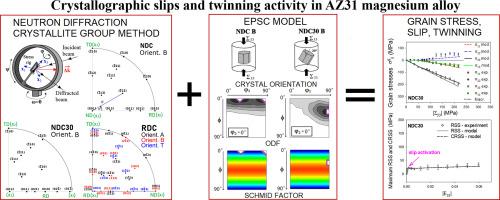在衍射实验和模拟的基础上,研究了AZ31镁合金在不同变形模式下的晶体滑移和孪晶活性
IF 13.8
1区 材料科学
Q1 METALLURGY & METALLURGICAL ENGINEERING
引用次数: 0
摘要
采用原位中子衍射、晶群法(CGM)和晶体塑性模型研究了AZ31镁合金在不同单轴加载条件下的塑性变形行为。这项工作的一个关键新颖之处在于,可以直接、独立于模型的确定单个滑移和孪晶系统的分解剪切应力(RSS)值,以及它们的临界值(CRSS),这些值来自于具有优选取向的晶粒中的晶格应变。该试验在常规沿法向(ND)和滚动方向(RD)加载路径的基础上进行了扩展,包括与ND成30°和60°夹角的压缩(称为NDC30和NDC60试验),这是以往研究中没有研究过的。值得注意的是,NDC30测试与衍射测量相结合,专门设计用于激活大多数晶粒的基底滑移,同时最大限度地减少孪生,从而能够清楚地识别该滑移系统并准确确定其CRSS。通过将模型预测的RSS值与每种活性体系的衍射测量值进行比较,首次确定了硬化参数。这些数据与宏观测试结果一起用于校准弹塑性自一致(EPSC)模型,该模型准确地再现了施加载荷下的应力分配、纹理演变和孪晶活动。该集成方法提高了CRSS输入的可靠性,并基于改进的Eshelby夹杂法调整了晶间相互作用,从而改进了镁合金各向异性塑性的建模。本文章由计算机程序翻译,如有差异,请以英文原文为准。

Crystallographic slips and twinning activity in AZ31 magnesium alloy during different modes of deformation on the basis of diffraction experiment and modelling
This study investigates the plastic deformation behaviour of the AZ31 magnesium alloy under various uniaxial loading conditions using in-situ neutron diffraction, the crystallite group method (CGM), and crystal plasticity modelling. A key novelty of this work is the direct, model independent determination of resolved shear stress (RSS) values for individual slip and twinning systems, as well as their critical values (CRSS), derived from lattice strains in grains with preferred orientations. The experiment was extended beyond the conventional loading paths along the normal direction (ND) and rolling direction (RD) to include compression at angles of 30° and 60° from the ND (referred to as NDC30 and NDC60 tests), which had not been investigated in previous studies. Notably, the NDC30 test, combined with diffraction measurements, was specifically designed to activate basal slip in the majority of grains while minimizing twinning, enabling clear identification of this slip system and accurate determination of its CRSS.For the first time, hardening parameters were determined by comparing the model predicted values of RSS with those obtained from diffraction measurements for each active system. These data, together with the results of macroscopic tests, were used to calibrate an elastic-plastic self-consistent (EPSC) model, which accurately reproduced stress partitioning under applied load, texture evolution, and twin activity. The integrated methodology enhances the reliability of CRSS input and improves the modelling of anisotropic plasticity in magnesium alloys by tuning intergranular interactions based on a modified Eshelby inclusion approach.
求助全文
通过发布文献求助,成功后即可免费获取论文全文。
去求助
来源期刊

Journal of Magnesium and Alloys
Engineering-Mechanics of Materials
CiteScore
20.20
自引率
14.80%
发文量
52
审稿时长
59 days
期刊介绍:
The Journal of Magnesium and Alloys serves as a global platform for both theoretical and experimental studies in magnesium science and engineering. It welcomes submissions investigating various scientific and engineering factors impacting the metallurgy, processing, microstructure, properties, and applications of magnesium and alloys. The journal covers all aspects of magnesium and alloy research, including raw materials, alloy casting, extrusion and deformation, corrosion and surface treatment, joining and machining, simulation and modeling, microstructure evolution and mechanical properties, new alloy development, magnesium-based composites, bio-materials and energy materials, applications, and recycling.
 求助内容:
求助内容: 应助结果提醒方式:
应助结果提醒方式:


